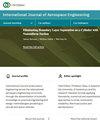基于对偶四元数法的6RUS并联机构正演求解算法
IF 1.2
4区 工程技术
Q3 ENGINEERING, AEROSPACE
引用次数: 0
摘要
6RUS并联机械手是一种通用性强、应用广泛的六自由度机器人机构。其复杂的运动结构及其执行复杂运动任务的能力近年来引起了人们的极大兴趣。6RUS机构的运动学分析对于了解其工作特性和优化其各种应用性能起着至关重要的作用。在本文中,我们提出了一种最先进的6RUS并联机器人的运动学算法。考虑到机构结构的复杂性,我们的算法旨在解决与准确确定末端执行器相对于基座的姿态和运动相关的挑战。通过利用先进的数学建模技术和高效的计算算法,我们提出的算法在确定6RUS机构的运动参数方面提供了更高的精度、效率和鲁棒性。这项工作的主要贡献包括开发了6RUS并联机器人的综合正运动学和逆运动学模型,该模型考虑了关节约束、奇异性和工作空间限制的影响。我们还对该算法的性能进行了详细分析,并与现有方法进行了比较,证明了其在计算效率和准确性方面的优势。所提出的运动学算法在提高6RUS并联机器人的设计、控制和轨迹规划方面具有重要的潜力。它为机器人手术、工业自动化和虚拟现实系统等高级应用提供了坚实的基础。本文提出的结果有助于增加平行机械臂研究的知识体系,并为该领域的未来发展铺平道路。本文章由计算机程序翻译,如有差异,请以英文原文为准。
A Forward Solution Algorithm of 6RUS Parallel Mechanism Based on Dual Quaternion Method
The 6RUS parallel manipulator is a highly versatile and widely used robotic mechanism with six degrees of freedom. Its intricate kinematic structure and its capability to perform complex motion tasks have garnered significant research interest in recent years. The kinematic analysis of the 6RUS mechanism plays a crucial role in understanding its operational characteristics and optimizing its performance for various applications. In this paper, we present a state-of-the-art kinematic algorithm for the 6RUS parallel manipulator. Our algorithm is aimed at addressing the challenges associated with accurately determining the pose and motion of the end-effector relative to the base, considering the complexity of the mechanism’s architecture. By leveraging advanced mathematical modeling techniques and utilizing efficient computational algorithms, our proposed algorithm offers improved accuracy, efficiency, and robustness in determining the kinematic parameters of the 6RUS mechanism. The key contributions of this work include the development of a comprehensive forward and inverse kinematic model for the 6RUS parallel manipulator, incorporating the effects of joint constraints, singularities, and workspace limitations. We also present a detailed analysis of the algorithm’s performance in comparison to existing approaches, demonstrating its superiority in terms of computational efficiency and accuracy. The proposed kinematic algorithm holds significant potential for enhancing the design, control, and trajectory planning of 6RUS parallel manipulators. It provides a solid foundation for advanced applications such as robotic surgery, industrial automation, and virtual reality systems. The results presented in this paper contribute to the growing body of knowledge in parallel manipulator research and pave the way for future developments in the field.
求助全文
通过发布文献求助,成功后即可免费获取论文全文。
去求助
来源期刊

International Journal of Aerospace Engineering
ENGINEERING, AEROSPACE-
CiteScore
2.70
自引率
7.10%
发文量
195
审稿时长
22 weeks
期刊介绍:
International Journal of Aerospace Engineering aims to serve the international aerospace engineering community through dissemination of scientific knowledge on practical engineering and design methodologies pertaining to aircraft and space vehicles.
Original unpublished manuscripts are solicited on all areas of aerospace engineering including but not limited to:
-Mechanics of materials and structures-
Aerodynamics and fluid mechanics-
Dynamics and control-
Aeroacoustics-
Aeroelasticity-
Propulsion and combustion-
Avionics and systems-
Flight simulation and mechanics-
Unmanned air vehicles (UAVs).
Review articles on any of the above topics are also welcome.
 求助内容:
求助内容: 应助结果提醒方式:
应助结果提醒方式:


